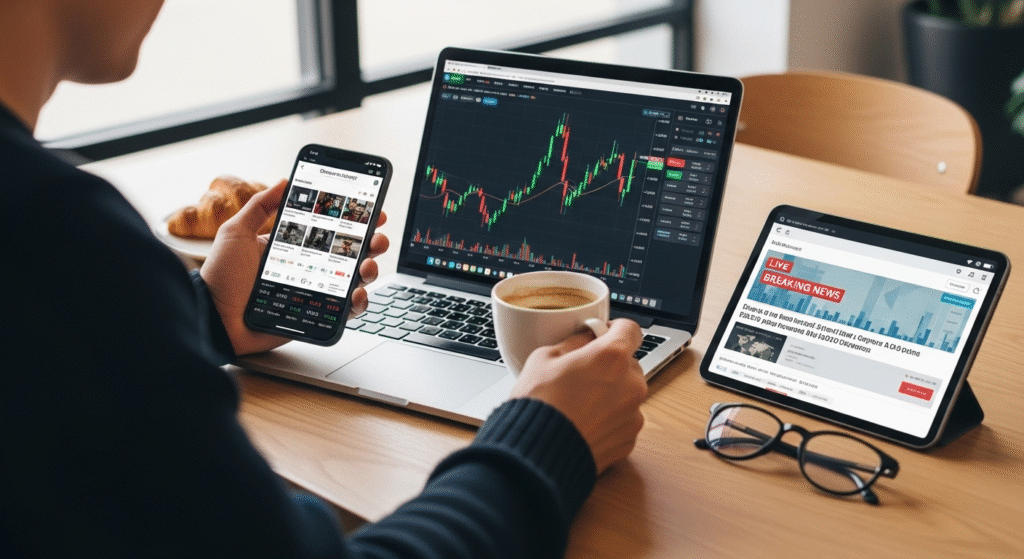
Trading has become one of the most popular ways for people to grow their money, whether in stocks, forex, or cryptocurrency. While it offers great opportunities, it also comes with risks that every investor must understand. Success in trading is not just about luck. It’s about knowledge, planning, and discipline. With the right approach, investors can avoid common mistakes and focus on strategies that deliver long-term results.
In this guide, we’ll share the top 9 trading tips every investor should know. These tips are simple, practical, and designed to help both beginners and experienced traders. By applying them, you can build confidence, improve decision-making, and increase your chances of achieving financial success.
Set Clear Financial Goals
Every successful trader starts with clear financial goals. These goals act as a roadmap, guiding your decisions and helping you stay focused. Short-term goals might include earning a specific profit within a week or month, while long-term goals could be building wealth over several years. Without goals, it’s easy to make emotional choices that hurt your progress.
When setting goals, be realistic and specific. For example, instead of saying “I want to make money,” you could aim for “I want to earn 5% returns each month.” Clear goals help you measure your progress and adjust your strategy when needed. In trading, goals also keep you disciplined and prevent risky behavior, ensuring you stay on track for success.
Understand Market Basics
Before diving into trading, it’s important to understand how markets work. Many beginners skip this step and lose money because they trade without knowledge. Start by learning the basics of stocks, forex, cryptocurrency, commodities, and indices. Each market has its own rules, risks, and opportunities.
Stocks represent ownership in companies, forex deals with currency exchange, crypto is digital money, commodities include items like gold or oil, and indices track groups of assets. Understanding these terms makes trading less confusing and helps you choose where to invest.
Basic knowledge also helps you analyze price movements and news more effectively. Without this foundation, it’s like driving without knowing the road. Taking time to learn market basics builds confidence and prepares you for smarter trading decisions.
Develop a Trading Plan

A trading plan is your personal guide that outlines how you will trade. It should include your financial goals, the markets you want to trade, how much money you’re willing to risk, and what strategies you’ll use. A plan keeps you organized and prevents random decisions.
Creating a plan involves defining entry and exit points, setting stop-loss orders, and deciding how much you will invest in each trade. For example, you might decide to never risk more than 2% of your account on a single trade.
The most important part is sticking to your plan. Many traders lose money because they let emotions take over and break their own rules. Discipline is the key—by following your plan, you trade smarter and protect yourself from unnecessary losses.
Start Small and Scale Up
One of the best trading tips for beginners is to start small. Many new traders make the mistake of investing too much money too quickly, which can lead to big losses. By starting with a small amount, you can learn how the market works without risking your entire savings.
As you gain experience and confidence, you can slowly increase the size of your trades. This gradual approach allows you to test strategies, learn from mistakes, and build skills safely. For example, you might start with $100, practice for a few months, and then increase your investment as you get better results.
Starting small also helps you manage emotions like fear and greed. It’s easier to stay calm when less money is at risk. Over time, scaling up will feel natural, and your confidence will grow alongside your trading results.
Diversify Your Portfolio

One of the golden rules of trading is: don’t put all your money into one asset. If you invest everything in a single stock or cryptocurrency and it crashes, you could lose it all. Diversifying your portfolio spreads your risk and protects your investments.
Diversification means investing in different markets or assets, such as stocks, forex, commodities, or crypto. This way, if one market is performing poorly, another may balance out the loss. For example, if stocks drop but gold rises, your portfolio stays more stable.
A diversified portfolio also allows you to explore multiple opportunities. Instead of relying on one source of profit, you create different income streams. This reduces stress and makes trading safer in the long run. Remember, spreading your risk is one of the smartest ways to grow wealth consistently.
Master Risk Management
Risk management is one of the most important skills for any trader. Even the best strategy can fail if you don’t manage your risk properly. The first tool every trader should use is a stop-loss order. This automatically closes a trade when the price drops to a certain level, preventing huge losses. Without a stop-loss, you could lose far more than expected.
Another key concept is the risk/reward ratio. This helps you decide if a trade is worth taking. For example, if you risk $100 but could earn $300, the risk/reward ratio is 1:3. A good rule is to only take trades where the potential reward is at least twice the risk.
Risk management also means never risking too much of your account in one trade. Many experts suggest risking no more than 1–2% of your total capital per trade. This way, even if you lose a few times, you can keep trading without wiping out your account.
Keep Emotions Under Control
Trading is not only about numbers; it’s also about psychology. Fear and greed are the two biggest emotions that hurt traders. Fear can stop you from taking good opportunities, while greed can push you to take unnecessary risks. Both can lead to poor decisions and big losses.
To keep emotions under control, always stick to your trading plan. Avoid chasing the market or entering trades just because prices are moving quickly. Instead, trust your strategy and follow your rules.
Another tip is to take regular breaks. Spending too much time staring at charts can make you anxious. A calm mind makes better decisions. You can also practice techniques like deep breathing or journaling to stay focused.
It’s important to remember that losses are part of trading. Don’t try to “win back” money quickly after a loss. Accept it, learn from it, and move on. By controlling your emotions, you trade with logic, not feelings, which greatly improves your chances of long-term success.
Stay Updated with Market News

News has a strong impact on trading because it affects how people see the market. A single announcement about interest rates, company earnings, or global events can cause prices to rise or fall quickly. For example, positive job data might make a currency stronger, while negative company results can cause stock prices to drop.
That’s why staying updated with market news is essential for traders. It helps you understand why prices move and allows you to make smarter decisions. Following economic calendars is also useful because they show when major announcements will happen. Reliable sources to follow include Bloomberg, Reuters, CNBC, and official financial websites. Social media can also provide updates, but always double-check information before acting on it.
Learn Technical and Fundamental Analysis
To become a successful trader, you need to understand both technical and fundamental analysis. Technical analysis is the study of price charts. By looking at patterns, trends, and indicators like moving averages or support and resistance levels, you can predict possible price movements. For example, if a stock keeps bouncing off a support line, it may rise again when it reaches that point.
On the other hand, fundamental analysis focuses on the real-world factors that affect value. For stocks, this includes company earnings, financial reports, and industry performance. For currencies, it may include interest rates, inflation, and economic strength. For commodities, supply and demand play a big role.
Learning both methods gives you a complete picture. Technical analysis tells you when to enter or exit a trade, while fundamental analysis explains why the market is moving.
Start with the basics and practice regularly. Even simple chart reading can improve your results, while understanding fundamentals helps you avoid bad trades. Combining both techniques makes your trading decisions stronger, reducing risk and improving accuracy.
Conclusion
Trading is not just about making quick profits. It’s about building long-term financial success with the right strategies. By setting clear goals, creating a plan, managing risks, and keeping emotions in check, you give yourself the discipline needed to grow steadily. Staying informed with market news and learning both technical and fundamental analysis helps you make smarter decisions. Remember, trading takes patience, consistency, and continuous learning. Every small step adds up over time. Stay focused, keep improving, and your trading journey can lead to lasting success and financial independence.
FAQs
What is the best time to start trading?
The best time to start trading is when you have learned the basics and understand how markets work. Beginners should avoid rushing in without knowledge. It’s wise to practice with demo accounts before using real money. Many markets, like forex, are active throughout the day, but stock markets run during specific hours. Focus on times when the market has higher activity and volume, as this helps with better price movements and opportunities.
Do I need a lot of money to begin trading?
No, you don’t need a large amount of money to start trading. Many brokers allow you to open accounts with small deposits. Beginners should start with a small investment to reduce risk and learn without losing too much. As your confidence and skills grow, you can increase your investment gradually. The most important thing is to protect your money by applying risk management strategies, rather than focusing only on how much you invest.
Can trading replace a full-time job?
Trading can generate profits, but it is not a guaranteed replacement for a full-time job. Many beginners think trading provides quick income, but in reality, it requires experience, knowledge, and patience. Some professional traders make a living from it, but they usually have years of practice and a strong risk management system. It is better to treat trading as an additional source of income until you gain enough skill and consistency to rely on it fully.
What are common mistakes beginners make in trading?
Common mistakes include trading without a clear plan, investing too much money at once, and letting emotions control decisions. Beginners often chase quick profits or ignore stop-loss rules, which can lead to big losses. Another mistake is failing to learn market basics and relying only on guesses. Avoiding these errors requires patience, proper education, and discipline. Start small, use strategies, and always focus on long-term learning rather than rushing into risky decisions.
Is it necessary to learn both technical and fundamental analysis?
Yes, learning both technical and fundamental analysis is very helpful. Technical analysis helps you understand price charts, patterns, and trends, while fundamental analysis focuses on the overall strength of a company, currency, or market. Combining both methods gives you a clearer picture and helps in making smarter trading choices. While some traders prefer one style, knowing both can give you more confidence and better results in the long run.